19/03/2018, 14:00
Mornings are for coffee and contemplation
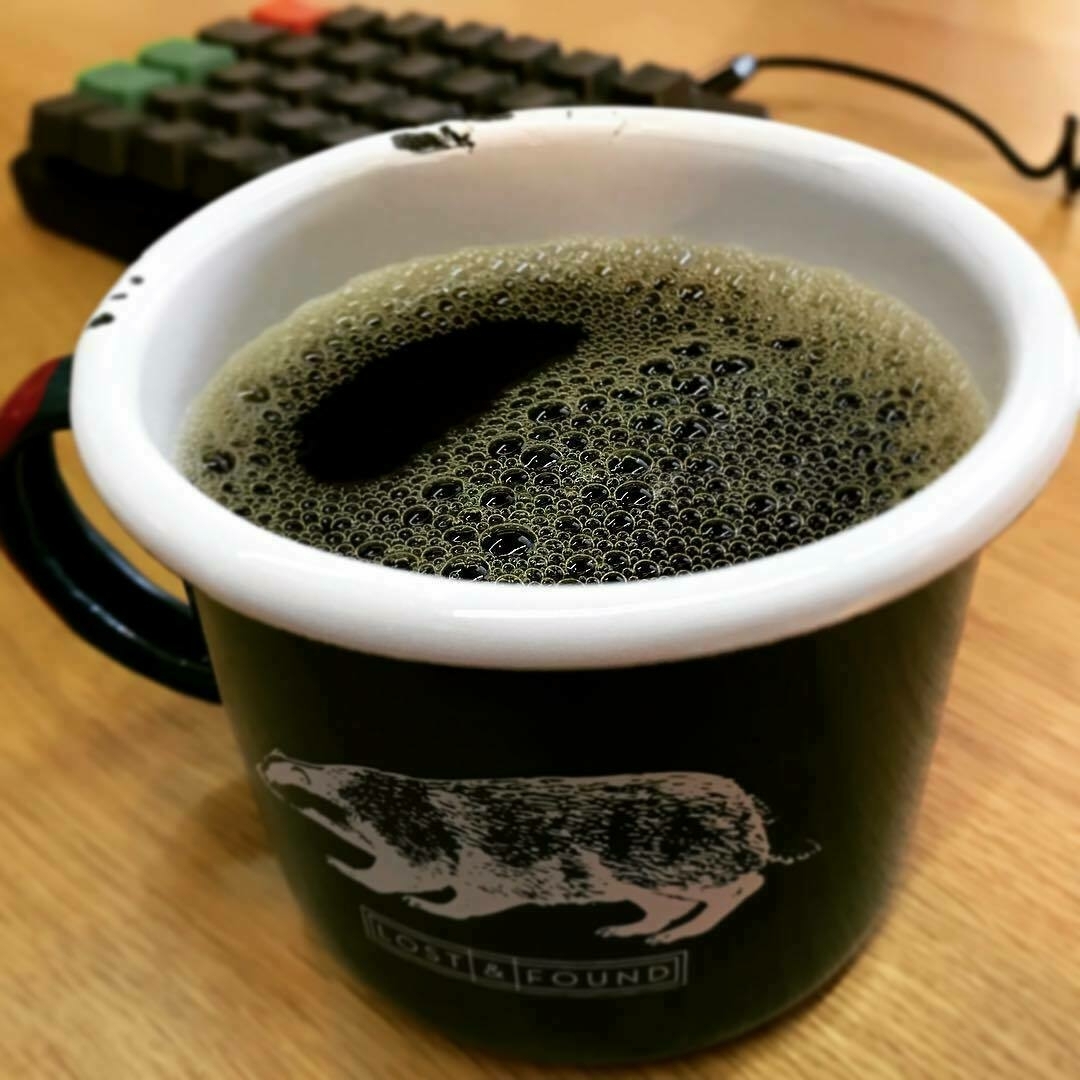
Mornings are for coffee and contemplation

Alongside the release of their new tabletop game, Warhammer Age of Sigmar, Games Workshop have been promoting several new type of eBooks from their publishing imprint Black Library. For a company who already sell three distinct versions of their books, what does this mean, what is this “new” format and what does it mean for gamers?
First let’s look at the books we’ve seen to date, they fall into 3 categories, Print, Enhanced (iBook) and eBook (EPUB 3 and Kindle).

 The print edition is exactly what you expect, the same hardcover format that we’ve known for years, or is it? Around the end of 6th edition and release of 7th edition 40K there was a shift in the design of the BRB and the Codexes. Compare the text heavy Codexes of 2nd edition to the new Codex Space Marines and you’ll see what I mean. The newer books are full of high quality, full page images, spacious type and high-res photography with a consistent styling between digital and print versions.
The print edition is exactly what you expect, the same hardcover format that we’ve known for years, or is it? Around the end of 6th edition and release of 7th edition 40K there was a shift in the design of the BRB and the Codexes. Compare the text heavy Codexes of 2nd edition to the new Codex Space Marines and you’ll see what I mean. The newer books are full of high quality, full page images, spacious type and high-res photography with a consistent styling between digital and print versions.
It seems as though the print version is now being designed alongside the digital editions, rather than being tacked on as an afterthought and shows that Games Workshop is serious about digital content. Perhaps they are even taking a “digital first” approach, it’s certainly possible as the print books now look a lot like the iBooks edition, but is more likely that they have well defined templates for both.
A quick note on Digital First Design. Generally considered a good thing, there’s no denying that it can lead to a fresher, more modern looking book. That said, we’re starting to see publishing industry push-back, especially in education, as there is a definite feeling of sameness, even blandness to a lot of digital books that then migrates to print. eBooks are more or less packaged web pages, so some upcoming CSS standards should improve typography and layout options, allowing for much richer “print-like” designs in the future.

 Not all ebooks and certainly not all eReaders are created equal. In the “real world” we can classify books as hardback, softback, comic books, coffee table, reference and so on. Here in the Matrix they’re all just “eBooks” and all formats are expected to work everywhere; this leads to Lowest Common Denominator Design.
Not all ebooks and certainly not all eReaders are created equal. In the “real world” we can classify books as hardback, softback, comic books, coffee table, reference and so on. Here in the Matrix they’re all just “eBooks” and all formats are expected to work everywhere; this leads to Lowest Common Denominator Design.
The latest James Patterson novel is ideal to read on your Kindle or Nook, but for anyone who’s ever tried to navigate Warhammer 40,000: The Rules on a Kindle Paperwhite mid game will find it to be a lesson in madness.
 The layout is perfectly nice but this type of reader isn’t really designed for this type of content, it’s designed for novels. So instead we chop up our beautifully designed to make it linear. It’s like printing out the content of the rulebook on copy paper. I’m sure some people like it this way or have low expectations for the technology, maybe they just want an easy way to read the fluff, but for gaming it’s a horrible experience all-round. Why? Because any digital book creates an inherently poorer User Experience that the physical equivalent. We “know” how to use a book and use it quickly, in a non-linear fashion, as we jump from reference to reference. But this isn’t how a typical eReader works, as it’s primarily designed for novels, anything beyond linear navigation is a feature that’s been bolted-on.
The layout is perfectly nice but this type of reader isn’t really designed for this type of content, it’s designed for novels. So instead we chop up our beautifully designed to make it linear. It’s like printing out the content of the rulebook on copy paper. I’m sure some people like it this way or have low expectations for the technology, maybe they just want an easy way to read the fluff, but for gaming it’s a horrible experience all-round. Why? Because any digital book creates an inherently poorer User Experience that the physical equivalent. We “know” how to use a book and use it quickly, in a non-linear fashion, as we jump from reference to reference. But this isn’t how a typical eReader works, as it’s primarily designed for novels, anything beyond linear navigation is a feature that’s been bolted-on.
This is a huge problem in Education as textbooks are also used in non-linear ways. eBooks that were initially seen as the way of the future, are now considered to cause more problems than the paper books they aimed to replace. This left room for companies like Apple and Inkling to come up with alternatives.
The most popular form of alternative eBook is the iBook working hand-in-hand with the iBooks application on Mac and iOS. The iBook format is a proprietary extension of EPUB 3 introducing some functionality unique to Apple WebKit and addressing the issues above by allowing richer designs and providing a more appropriate reading experience.

As with Digital First Design this was at first considered a good thing.
Introduced by Apple at an education-focused event in 2012 the iBook was designed to solve the problem of creating digital textbooks. It allows anyone to create beautiful content specifically for Apple devices by using a WYSWIG editor and embedding interactive widgets like quizzes and galleries and an interactive glossary. The big improvement over standard EPUB 3 was the custom reader that Apple included in the iBooks Application (yes the format and reader are called the same thing. Yes there was also a laptop by the same name too) which provided a more natural method of navigation that your standard eReader. Using gestures you can swipe between Chapters, Sections and Pages and pan and zoom in and out to jump around in content.
Games Workshop started publishing books in this format back in 2012 and it finally seemed that a perfect format had been discovered for digital gaming books. If nothing else it certainly felt premium, further cemented by the release of Codex Space Marines which included enhanced features like embedded audio and the Force Requisition army builder.
It was around this point that I switched from print to digital, but as good as the iBooks format is, it does have issues. First off it’s iOS only and until very recently was iPad and Mac only. Secondly it’s slow. So slow. Apple added animated book opening effects to the iBooks software meaning that jumping from one section of a book to another (without a hyperlink) can take up to 10 seconds; in the heat of a game, that is way too long.
[caption id="attachment_10367" align="aligncenter" width="990"] This is a real-time animated gif of an iBook opening on a 2014 MacBook Pro.[/caption]
This is a real-time animated gif of an iBook opening on a 2014 MacBook Pro.[/caption]
There are problems for publishers too, the books can only be built using Apple’s proprietary iBooks Author tool, effectively introducing an additional development track to the publishing workflow and only sold through iBooks, for which Apple take a 30% royalty. This is why publishers like Amazon and Comixology have removed all buying functionality from their apps, you can buy books from their online store and then download it to your device afterwards. It’s not a great experience for users but I can see why they do it, 30% is a huge junk wether you’re an indy publisher or a multinational.
I believe it’s been the dual pressures of providing high quality ebooks for non iOS users and a way to reduce the Apple tax on sales that has likely driven the creation of the new format released alongside Age of Sigmar.


 The ebook formats, EPUB 3 and Mobi, get a bad wrap. If you’ve seen the digital version of White Dwarf magazine you’ll know why. This is the same format that publishers use for novels, which obviously works well there, but makes it impossible to create more than the simplest of layouts. Known as “reflowable ebooks” this content will “flow” from screen to screen allowing you to change the font to suit and making it readable on any size of device.
The ebook formats, EPUB 3 and Mobi, get a bad wrap. If you’ve seen the digital version of White Dwarf magazine you’ll know why. This is the same format that publishers use for novels, which obviously works well there, but makes it impossible to create more than the simplest of layouts. Known as “reflowable ebooks” this content will “flow” from screen to screen allowing you to change the font to suit and making it readable on any size of device.
Reflowable EPUBs can be created easily in many word processing packages and desktop publishing tools like Pages and InDesign or generated from a folder of text files. Content is king which is why the focus is put on type in this format, but compared to the the print or enhanced edition it looks like something your Nan could do in Microsoft Word.
What it does have going for it is that it is quick to produce and can run on pretty much every device. If you’ve bought the DRM free ebooks from Black Library, you’ll get a Kindle edition too (most publishers generate their Kindle books from the EPUB 3, which is why I didn’t include it on the list of formats.) Publishing through Black Library also allows Games Workshop to save the 30% that Apple takes on fees. Some may ask why GW don’t charge 30% more for books sold through iBooks and I’m sure they would if they can but Apple’s T&Cs stop you from charging a higher price for the same product on their store. On of the disadvantages of the Black Library is that for less technical users it can be pain to download and transfer ebooks; the Kindle is so successful due to the tight integration of eReader and store.
Two weeks ago my article would have stopped with the eBook edition, however Warhammer Age of Sigmar brought along a new flavour of eBook; no longer would Android or mobile users have to suffer the poorly laid eBooks we’ve seen in the past.
The recent iOS 8.4 update means the iBooks editions work on iPhone, so there’s no reason for iOS users to buy multiple formats.
The first of the new books was the Age of Sigmar paining guide, you can and should grab a sample of this on the Black Library site and in iBooks, it looks lovely. Or should I say they look lovely because the tablet and mobile versions have appropriately different designs and using an app like Calibre or Kindle Previewer you can freely and legally convert them to work on your Kindle too.


Like the standard eBooks, these are also EPUB 3 but used the fixed-layout flag in their config, this let’s publishers set a page size in pixels and layout the content exactly as they want it to show. Beautiful looking eBooks and on mobile too, have we just found the holy grail?
No actually. The fixed layout format has fallen slightly out of favour with publishers for a number of reasons, the biggest of these is that eReaders treat this type of content like a PDF in a few ways.
As each page in a fixed layout eBook is a single HTML (XHTML actually) page, iBooks uses the webkit rendering engine to process each page and generate a thumbnail, letting you scrub through pages quickly. However iBooks doesn't really cope with scale, possibly because people didn’t consider the 250+ page behemoths that we see in gaming and in education. Image trying to open 250 graphics heavy web pages at the same time, that’s what opening a large fixed layout book is like. Thankfully once it’s finished processing the book works great but on older devices like the iPad 2 or original iPad Mini you might find that iBooks crashes each time you try as it comes up against the memory limit on the device.
There’s nothing wrong with fixed layout EPUB 3 per se, it’s just that the eReaders let us down again; the portable reading experience is very different from the printed and should treated as such in both the design of the books and the eReaders used to consume them. So what is this format good for? In my line of work we use it a lot of kids’ story books and direct conversions of legacy books when stakeholders require a 1:1 match between print and digital; it’s generally considered as something of a step-backward in this case.
Unlike the iBooks (enhanced) editions the new fixed layout EPUB’s don’t require a separate development track, they’ve been generated from InDesign automatically, you can see this in the metadata section of the image below. For template driven content like this, once you’ve got a your first project set up, there is little to no additional work to generate fixed layout content for new books. Beyond clicking the export button that is.
So think about this, Games Workshop now makes a book once and can now export automatically to print, mobile, tablet and probably even ebook editions but instead of users buying a book and getting access to whatever format is necessary, users are encouraged to buy the same book multiple times generating almost pure profit for
I’ve said before that I have no problem paying the same for a digital book as the print edition, but this only applies to “prestige” formats like iBook edition, or Comics on Comixology, where care has been taken in the design and implementation to provide a better experience, e.g.. the special features added to the latest Codexes. Like many of you I’ll even go as far as to buy the print and digital editions of some books and the Horus Heresy series from Forge World is the type of book you’d only ever want in physical form but I have to draw a line at paying twice for what is the same thing.
There is no technical reason that the mobile, tablet and ebook editions shouldn’t all count as the same purchase, there’s even an argument that they should be available as a download with every print book or perhaps even charge a small premium like Marvel do with comics. I can’t help but think the iOS 8.4 update came at a bad time for GW, you’d think that with the number of iPhones in the market they wouldn't miss out on telling people that their books now work on iPhone too. Unless of course they want mobile users to buy another copy. (Of course they do.)
For my money I’ll continue to buy the iBook (enhanced) editions, the app may be slow, but it’s improving and as eReader designed for education its support for annotations and glossaries is second to none. The fact that I can now get these books on my iPhone only helps seal the deal. If I ever move to Android, yes that means I’d loose access to my books, but as it stands now I’d need to pay twice to have the appropriate book on both my Android tablet and mobile.
As someone who makes eBooks for a living, this might sound like I’m shooting myself in the foot, but be careful when buying eBooks, not only are you subject to lock-in in various book stores, but the terms and conditions from some publishers may mean that you never own the content and trying to convert from one format to another may mean you are actually in breach of their terms.
Always look for DRM free options where possible never be afraid to push back on publishers to improve the quality of their ebooks. You wouldn't stand for a brand new printed Codex if the cover was hanging off and the ink smudged on a bunch of pages, digital products should be no different.
Tablet form factor is an interesting thing; an iPad user since day one, I sold my iPad 2 after using the Nexus 7 for a week last year, but once the iPad Mini was released I jumped at the chance to own an iOS device in the 7" form factor. I am a Mac user, my primary phone is an iPhone, and regardless of how good the Nexus 7 is , the iPad fitted with my workflow, seamlessly. Setting the availability of certain apps aside (OmniFocus, OmniGraffle are both Mac apps that are available on iPad too) I'm not saying I can't use anything else, but at the moment, I don't want to, but that doesn't mean I won't try.
Through my day-job at Purple Guerrilla I've had the opportunity lately to test on all of the major 10" tablets. Despite going in with some pre-formed opionions about what I would and wouldn't like, I found the results quite surprising.
 First up, the "New" iPad, not the newer iPad, commonly referred to as the iPad 4. The differences are minor enough that for the purposes of this test, I'll consider them as one and the same.
First up, the "New" iPad, not the newer iPad, commonly referred to as the iPad 4. The differences are minor enough that for the purposes of this test, I'll consider them as one and the same.
The 10" iPad is a beast. I remember when the first iPad was released, it was like something from sci-fi, the iPad 2 form factor slimmed this down further, but compared to an iPad Mini, it's still huge. If you don't have an iPad Mini you have to understand just how slim a device it is. I was watching actual, near future, sci-fi a few weeks back and an iPad Mini used as a prop, looked so futuristic that I found it jarring.
There's something about the iPad's "premium" build quality and weight (slightly heavier than iPad 2) that make it feel very fragile; like handling your Granny's best china. Nexus devices get a bad rap for feeling cheap, but I have no qualms throwing one down on a coffee table; if I tried that with an iPad it would probably slide right off.
I really wanted this to be good, I genuinely mean that. I'm so divorced from the Windows way of doing things (since I installed that first free Red Hat CD from PCW Magazine) that I actually like Windows 8 and its Modern UI. The problem is that despite all the marketing and posturing, the Surface Pro is not a tablet. The Surface RT is a pretty lack-lustre device, but at lease it is a tablet, the Pro, despite the name is a completley different device. The closest comparison that I can make is that this is Microsoft's MacBook Air, it's a fully featured, Intel based, ultra portable notebook.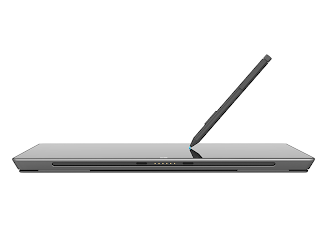
The problem's started when I was first handed the device. The Surface Pro is so heavy that you wonder what they've filled the device with. (This article is not about facts and figures, but about experiences and sensations; the things that actually matter when using these devices.) I know from The Verge's excellent review that the Pro is half a pound heavier, that makes this 10" "screen" it heavier than my 15" Macbook Pro.
Too heavy to use as a tablet and with an active battery life of no more than 4 hours, it seems that the Surface Pro is designed to be used at a desk. The inclusion of a Display Port for video out only reinforces this, as does the inability to charge via USB (like every other tablet), both Surface models require a reasonably large power brick. Whilst chained to my desk via power cord I noticed another problem, the Surface Pro comes with a stylus which clips limply into the side of the device, using the same magentic port that is used for the power adapter. So, that's going to get lost soon.
As metioned previously the Modern UI really appeals to me, so nothing is more frustrating that launching an app and being kicked straight into "Classic" or Desktop mode cough Office cough. I wish there was a more clear division, even a switch to disable the traditional Desktop and the apps that require it, however it seems most long-time users have more of an issue with Modern UI and want to kill it and reclaim their Start button.
Microsfoft like to compare their devices against those from Apple, recent ads have shown off the Surface's true HD (1080p) display and 64GB storage as standard, so it was a little surprising to find that roughly 40GB of that storage are taken up by Windows 8 itself. 40GB, just think about that for a moment. Imagine buying a 16GB iPad to find you have only 6GB of usable space, people are already outraged by the 1GB or so that they currently loose to iOS,
The Surface Pro could be a successful device, if I was working in a Windows environment, I'd certainly take it over a Lenovo Thinkpad, but as a tablet it would be easy to carry around one made of stone. It's also prohibitively expense, £719 without the essential keyboard/cover.
As some people will think that there was no chance I'd find any redeeming qualities in the Surface, I made this list of things that I do like.
I know it's been out a while, but the Nexus 10 (or any 10" Android) was never really on my radar. Thinner and lighter than the iPad and with the a 300dpi display, the Nexus 10, despite being made by Samsung (I generally find Samsung devices to be plasticky) is easily the best Android tablet I've used to date.
Android Jellybean 4.2.2 is not all that different from I last remember it, it's an incremental release, but one that makes the OS feel a little more coherent. For example calendar events from my Exchange account show in Google Now, previously Exchange email and calendars were left out in the cold; I guess Google thought no one in business would use a Google device. The "holo" interface, introduced in 4.0, brings coherency to what was a very fragmented UI (similar to what iOS 7 will hopefully do for Apple), Android looks futuristic, but is still very useable; not an easy feat to manage.
The device itself is strange, while the iPad is very uniform, the Surface solid (like the 2001 Monolith) the Nexus 10 is a bit "wobbly". With rounded corners and a asymmetric thickness, the Nexus 10 looks soft and friendly. It's also remarkably easy to hold in one hand, like a book. Something which I find painful with a large iPad and impossible with a Surface Pro. Sideloading of content to Google Books, extended Google Drive functionality, better Exchange support and a beautiful 300DPI display have made the Nexus 10 a real joy to use and I've found myself reaching for it over any other device
The one thing (literally the one thing) that lets the Nexus down is the fragmented Android development environment. When Apple released it's retina devices, with much fanfare, it provided the tools and incentive to developers to make their apps retina ready. Whilst almost all (citation needed) new iOS apps are built with retina support and pixel doubled graphics, most apps on Android that operate without the "Holo" UI have yet to be updated. The worst offender, Comixology, who already have HD comics on iPad but on the Nexus with an even higher dpi count, we're still looking at the low-res version. Digital comics may not interest you at all, but the principle is this, that the world leader in this vein of digital media, 5 months after launch, has not updated their app to support the Nexus 10's screen. My suspicion (based on limited Android development) is that the problem is not with Comixology, but with the Android SDK and the difficulty inherent with developing apps at multiple screen densities, for countless variations of device.
I've watched the coffee pod wars with a kind of bemused detachment. I don't need another way to brew coffee and the Nespresso and Senso brewed coffee I tasted was pretty bad.
The last thing anyone needs is an expensive way to make flavoured Nescafe
You'd think that'd be the end of it, but I really wanted to play around with one of these machines.
Instagram filter used: Hudson
Photo taken at: Blue Bottle Coffee - Kiosk
Instagram filter used: Hudson
Instagram filter used: Inkwell
Photo taken at: Kilkeel :)
Instagram filter used: Kelvin
 This weekend Starbucks released VIA Ready Brew, their take on instant coffee, throughout the UK. To coincide with the launch they ran a series of tastings pitting the Colombian and Italian Roast VIA against their "freshly" brewed Colombian and House Blend. Starbucks isn't known in the industry for the freshness of it's beans. Nearly two years ago I blogged about a change in message from Starbucks USA; admitting they had had quality problems and launching a new house blend "Pike Place" which would be in stores within two weeks of roasting. Although expected at the time, this return to freshness never arrived in Europe. Less than a year later, in what seemed a contradictory move, Starbucks entered the Instant market with VIA; 100% microground soluble coffee bean, however that's done.
This weekend Starbucks released VIA Ready Brew, their take on instant coffee, throughout the UK. To coincide with the launch they ran a series of tastings pitting the Colombian and Italian Roast VIA against their "freshly" brewed Colombian and House Blend. Starbucks isn't known in the industry for the freshness of it's beans. Nearly two years ago I blogged about a change in message from Starbucks USA; admitting they had had quality problems and launching a new house blend "Pike Place" which would be in stores within two weeks of roasting. Although expected at the time, this return to freshness never arrived in Europe. Less than a year later, in what seemed a contradictory move, Starbucks entered the Instant market with VIA; 100% microground soluble coffee bean, however that's done.
When I finally got a sample I was left very confused, here's why:
Pro
Con
This last point surprises me and hints to a possible lack of quality control, unusual for a company synonymous with producing homogenous products; at least it assures you that it's real coffee.
Another issue, brought up on Saturday at Open Coffee Banbridge, was that VIA is not Fairtrade; despite Starbucks' promotion last year, that all their coffee is now Fairtrade. Another apparent contradiction to their existing message. I've already written about Fairtrade's strengths and weaknesses. Yes it's good for consumers to buy Fairtrade, providing they realise that it is not the only or even best way to give farmers a fair price; for companies it's a completely different matter. Too often used as ready-made promotion, Fairtrade is the bare minimum that a business can and should do to be ethically responsible. The Bible says that "all our righteousnesses are as filthy rags." This isn't the correct exegetical interpretation, but when a business switches to Fairtrade for the wrong reasons, it is nothing more than filthy rags, a front, which I hope the customer can see past. Through the release of VIA without it being Fairtrade, is it possible that this is the case with Starbucks?
Taste and Fairtrade aside, the real VIA challenge however, is to convince the UK public to spend 50 pence on an individual sachet of coffee!
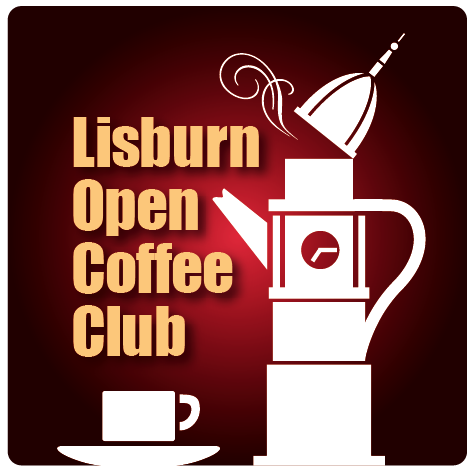
The Open Coffee idea was born in London "to encourage entrepreneurs, developers and investors to organise real-world informal meetups to chat, network and grow."
Started one year ago, and held on alternative Friday mornings, the Open Coffee Lisburn branch has proven to be a huge success, drawing in techies, bloggers, entrepreneurs and more. Most importantly this random, free and open networking group has, for a lot of us, created real-world friendships.
The openness and social nature of Open Coffee, compared to the strict regimented structure of other business networking groups, such as BNI means that we can try different things. So on Saturday 16 January, we'll be having our first Open Coffee Lisburn outside of Lisburn, in Banbridge. "On Tour" as I like to call it, we'll be meeting at 9:30AM in Starbucks at The Outlet. With most attendees being married and with kids, we encourage you to bring the family along too, it'll be a great social event.
If you've never been along to an Open Coffee meeting, this is the perfect opportunity to come along and meet the group.
You can contact us on twitter through http://twitter.com/oclisburn
The majority of us are on Google Wave and if you add me, I can invite you to the group - andrewgribben.com@googlewave.com
And finally, you can keep up with our events by subscribing to our iCal
 Sounds tasty right? Well as tasty as it may be it's not the food and drink I want to talk about. That's the title of my wife Lila's blog (@mrsbeanandgone) which she started yesterday.
Sounds tasty right? Well as tasty as it may be it's not the food and drink I want to talk about. That's the title of my wife Lila's blog (@mrsbeanandgone) which she started yesterday.
It's only one post for now, but I'm sure when she finds time out from looking after our 7 week old daughter, we'll be hearing more from her.
Check it out - Coffee and Chocolate Cake
I took the time today for a little bit of overdue DIY and built a rack for pour-over/filter cone coffee. We'll be bringing this out at the next BEAN AND GONE stall at the Lisburn Farmer's market, along with a whole variety of coffees to brew on it, more on that soon.
If anyone wants one of these, we're thinking of building them and selling them for around £35-40. Contact @grib if you're interested.


 See and download the full gallery on posterous
See and download the full gallery on posterous
<p> <a href="http://posterous.com/">Posted via email</a> from <a href="http://andrewgribben.posterous.com/diy-filter-cone-rack">Grib's Stuff</a> </p> 

 See and download the full gallery on posterous
See and download the full gallery on posterous
<p> <a href="http://posterous.com/">Posted via email</a> from <a href="http://andrewgribben.posterous.com/feile-fm">Grib's Stuff</a> </p> 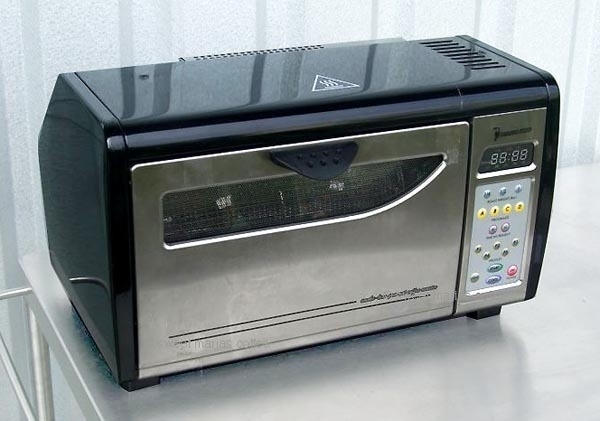 The ever pleasant, ever knowledgeable Steve Leighton of Has Bean fame, kindly lent me a prototype coffee roaster last month at the cost of a review. Being me, I promptly
The ever pleasant, ever knowledgeable Steve Leighton of Has Bean fame, kindly lent me a prototype coffee roaster last month at the cost of a review. Being me, I promptly got caught up forgot about it and so last night was actually the first time I got to power it on.
For those of you that have never heard of the Behmor 1600, it's a home coffee roaster that's been on sale in the States for a while now and the developer of it will soon(?) be releasing a model that works on the juicier 240V we have at this side of the Atlantic. What's so special about this roaster you ask? Well as Tom at Sweet Maria's says "There's finally a home coffee roaster that can truly do a full pound of coffee!" that's 453g in new money. That's a great weight, roughly twice what I can roast in my Gene Cafe and it has a host of amazing features, quiet roasts, smoke free, consistent roasts etc.
So what did I think of it?
Well first off, it's a great size, pretty much the same a our microwave, which means it can happily sit on the worktop and not look like a warp core which keeps my wife happy.
The control panel looks quite complicated and the manual even more so. I can almost forgive that, as the major of users will be coffee geeks, but I had to read it through twice just to be sure I was doing things right and that does seem excessive, either that I was just having a really stupid day, who knows?
The smokeless filter is a nice touch and does a really good job up to a Full City (ish) level, after that you're likely to get a charcoal'd bean anyway, but as a lb of colombian decaff found out last night, no amount of smoke filtering will help when your beans roasted to the point of starting a fire. Which brings me to the negative...
Visibility. Frankly it's terrible. Due to the nature of the machine you really have to open the door and remove the chaff tray during the roast (which will affect the internal temperature) to have a good look at the beans. The above problem happened because I ended up shining a maglite in to see how the roast was getting on and completely misjudged it. This paragraph was originally going to be quite scathing, but I found out after cleaning there is actually a light inside the roaster (the clue being the button marked "light" on the panel. So maybe I was having a stupid day after all) however the bulb in this model wasn't working, I'm assuming it's just went during transit/usage or because it's a protoype, but I'll get that replaced today and I'm sure it'll be a help.
In summary, the Behmor 1600 is an innovative roaster which is intended to live in your kitchen, like any other appliance, with a wide range of temperature profiles and settings it more than makes up for over complicated instructions and will probably help you understand the coffee roasting process better anyway.
In the next part of my review I'll be looking at the pre-set curves and range of roasts available and then wrap up by comparing and cupping roasts against my other home roasters.
Remember these are just my initial thoughts and I will continue to make posts as I roast with it more.
This coming Saturday, 6th June, Castle Gardens hosts the latest Lisburn Farmer's Market.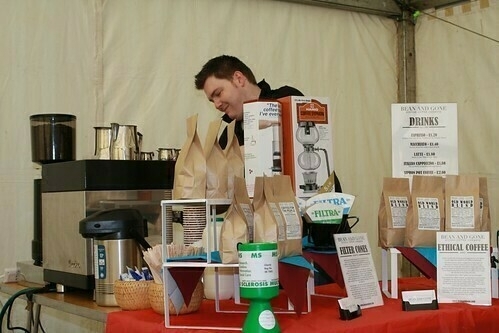
Rising above past criticism and terrible weather, the May market was success for all involved, both traders and most importantly customers. The summer-like weather, donkey rides, Art on the Rails and the market itself created a enjoyable experience for all and drew in new visitors, with the tent being packed all day long.
We'll be there again this Saturday, with a wide range of BEAN AND GONE artisan coffee beans and serving drinks too. This month we'll be selling some exciting single origins coffees that aren't available on our website, including; Guatamala Cup of Excellence Perla Anexos and a new Kenyan coffee, Kitamaiyu Estate AA .
Hopefully the great weather will hold and we'll see you there!
Available now in the iTunes Store, Find Me Coffee will show you the nearest speciality coffee shop, cart or roastery.
I was pleasantly surprised after heading home from Open Coffee Lisburn tonight, to find a nice email from Apple telling me the Exile Coffee "Find Me Coffee" app was now "Ready for sale"
 Unfortunately it's not that simple, I seemed to have overlooked part of my banking setup on iTunes Connect. I'll get that sorted out right now, but hopefully the app will be ready available soon. If you're developing for the iPhone yourself, take heed from me, don't cut corners, fill in details properly and you'll be a 59c millionaire before you know it!
Unfortunately it's not that simple, I seemed to have overlooked part of my banking setup on iTunes Connect. I'll get that sorted out right now, but hopefully the app will be ready available soon. If you're developing for the iPhone yourself, take heed from me, don't cut corners, fill in details properly and you'll be a 59c millionaire before you know it!

Open Coffee Lisburn meets tonight at 1900 hours, upstairs in Ed's Express up by Lisburn Omniplex. I wouldn't normally announce Open Coffee every week, Russell already has that covered, but I wanted to share a few things that are on my mind:
Too many animal metaphors in one paragraph, apologies.
Coffee is a passion for me, anyone who has talked to me, knows I could wax lyrical about it. I thoroughly enjoyed being at last month's Farmer's Market and spent the following four weeks looking forward to it, preparing new beans and telling everyone that would listen about how great it was to have something like this in Lisburn. Yesterday, despite being there to sell BEAN AND GONE coffee beans I was told, mid-market, to stop giving away sample drinks, because it was affecting the business of another trader. Annoyed and offended, I sent out a quick tweet and was shocked by the near instant support of the local online community. Russell (@wiseguyrussell) has posted about it on his blog and others @blackconfetti, @odle2, @maramgrass, @stuartgibson, @wiredbob expressed their indignation, both in person and online.
People have been talking about free trade and the unfairness of having a market that allows no duplication. I signed up for the market knowing this and accepted that I couldn't sell coffee drinks and only give samples away. I wanted to write a detailed timeline of what has been happening and allow everyone to make up their own minds.
About Our Ratings
Our ratings are not intended to cause offense, but instead hope to promote quality and good practice in the coffee industry, directing business owners to the areas that need improvement, providing a better experience for all.
As such, the breakdown of our reviews, based on the sampling of a small cappuccino, is as follows:
Taste - Pretty self explanatry, how the coffee tastes. Marked out of 10, most fresh generic coffee's will receive a 7 or 8, outstandingly fresh and exciting coffees will be higher, with stale coffee (usually caused by filling the doser with ground coffee and leaving to sit, or not cleaning group heads between shots) will be lower.
Texture - The texture of the milk, also marked out of 10. Consistently smooth milk with little or no bubbles, known as microfoam, is the goal here. Frothing milk until it is bubbly and dry tends tomake it sour and points will be lower accordingly.
Temperature - Leading on from milk frothing, the coffee temperature, again out of 10 with 10 being the perfect drinking temperature, not too hot not too cold. Extreme heat (hotter than your hand can touch, around 140F) not only makes the milk sour, buttwill get you lower points; no one wants their mouth burnt!
Technical Ability - Marked out of 10, this is a look at the skill and training of the barista preparing the drink. Are they following industry best practices, or ritualistically sticking to bad/incorrect training. Also taken into account are the proportions of the drink, ie the ration of espresso to milk.
Appearance - Marked out of 5, this is not how the staff look, contrary to popular belief (you know who you are!) but is how the coffee is presented, if it is finished with any latte art, if there have been spills etc.
Atmosphere - The atmosphere marks relate to the cafe environment itself; is the establishment billed as a "coffee shop" but the main priority is food and a high turn over of customers. As it is not a major issue it is also marked out of 5.
The final score is calculated by adding these values together and doubling to give a mark out of 100
Exclusions - We have decided to exclude certain coffee chains from our reviews due to bad ratings across their stores. Currently O'Briens, The Streat, Costa Coffee, Cafe Nero and Starbucks are excluded. Although, as I alluded to in an earlier post, Starbucks Coffee, prepared primarily by fully automatic machines, is at least consistent.

Yesterday was a long day, for no one more so than the baristas that competed in the Northern Ireland heat of the UK Barista Championship.
Only eight competitors took part in the smaller than normal competition, but there was certainly no lack of intensity in this fascinating exhibition of their skills and coffee knowledge. The eight competitors, in order of appearance were:
Judith McVitty - Clements, Royal Avenue
Neli Petkova - Cafe Krem, Banbridge
Heather Jamison - Quail's, Banbridge
Michael McLauglin - Clements, Royal Avenue
Jon Armstrong - Coffee Republic
Rachel Mawhinney - The Streat
Julia McKenna - Clements, QUB Student Union
Luke Powell - Cafe Krem, QUB Peter Froggart Centre
In no time at all the day was over and everyone nervously waited the return of the judges, hoping it would be before the impending close of the building (the organisers were told we had to be out by 5pm). And the top three were:
First - Neli Petkova
Second - Heather Jamison
Third - Julia McKenna
I want to congratulate everyone who took part, as a spectator, you could really feel the tension on the room as each competitor took the stage and they made it the enjoyable day that it was.
You are probably wondering what happens next on the blog? Well my friend Jessica was there yesterday taking photos, (that’s where I stole the ones you can see here) and she will be uploading and possibly commenting on them too. Once I get those, I will give my review of the top two performances, as I unfortunately missed Julia’s (sorry Julia!), both were very different but watching them redefined not only the importance of speciality coffee, but the importance of coffee itself over the performance, something that in recent years seems to have been forgotten about.
As a topic of interest, Neli and Julia are from cafes in the top five of my Cafe Reviews. Sadly for me, Sinammon in Stranmillis was not competiting, although they were spectating. The standard of the baristas in Sinammon (my highest rating, btw) is such that they really will be one to watch in years to come.
As you can see from the post below I tried my hand at live blogging, which worked for a while, only to be thwarted by Three deciding to perform a "network upgrade" and killing my mobile broadband. Thankfully I did get some great audio recording, which I will be tidying up this evening, from both face to face interviews and a recording of the rooms PA, for the bits that I missed. I’ll be uploading them over the coming week, I don’t want to put up too much as I have a lot to write about, after some really interesting and unexpected conversations about the industry with Se Gorman (Cafe Krem), John (Clements), Philip (Johnson Bros Coffee) and Russel Bailie (Bailie’s Coffee). I also hope to be contributing to Common Grind, so I’ll have to get something to Chris for his next podcast.
Thanks to everyone that let me speak to them yesterday, my interview skills aren’t up to much and apparantly I’m "shy" too, so it went better than expected. I know I sound like a Kate Winslett now, but I also need to thank Sanremo, again I’ll be talking about their machines later, but my short opinion of them, awesome. I spent some time playing about with the third machine at the back, mixing with other Baristas and coffee lovers and after Russel gave the grinder some TLC we were pulling some consistently good shots.
One more thing, my rubbish latte art is my fault and mine alone, this much I have learned, now to tidy that audio…
Photography Thanks to Jessica Odell
The live blog is long and rambling, I've moved it behind the link below to tidy up the front page a litte.
16.40
1. Neli Petkova - Cafe Krem
2. Heather Jamison - Quails
3. Julie McKenna - Clements
16.39
Top 24 from the UK go to finals
16.38
I spy a bag of hasbean coffee
16.36
The judges are back
16.32
Internet problem caused by being in an area where 3G ends and 2.5G starts, meaning the wireless card spends most of its time flicking between bands instead of actually working.
16.20
Just awaiting the result from the judges, lots of nervous baristas standing by
16.17
Apologies for the lack of updates, we lot internet connectivity earlier, thankfully the recording seems to have worked ok, so I'll review the final baristas later
14.20
Two minute warning.
Mixture served into the cups prepared earlier
Time called, well done Jon
14.17
Small amount of peppermint tea, chocolate, condensed coconut, fresh coconut milk and black pepper in a jug and stirred,
Ice added to jug with a squirt of lime juice and the mixture above sieved in.
Now to add espresso, but to be served cold.
14.16
Speciality drink details
Infusing peppermint tea, cutting up lime, melted sweet chocolate.
Lime for the rims of the cups, dipped in melted chocolate
5 min warning
14.15
8 varieties of bean, including robusta because it cuts through the milk well, caramel finish with chocolate hints.
14.12
Recommends an extraction time of 20-25s for this blend
14.09
Espresso uses Brazil Daterra yellow bourbon, with citrus notes and dominican republic, med acidity, wine like towards the end.
Separate blend for cappuccinos and signature drinks, the coffee republic house blend
14.07
The next competitor is Jon Armstrong from Coffee republic, formerly of Clement's. A coffee legend in Northern Ireland and he knows it.
13.51
Honey roasted parsnip macchiato, again, that's very different
Only two minutes to go
13.48
5 minute warning
13.46
Since the burner won't start Michael is steeping the parsnips in milk before steaming them from cold. Yes I have confirmation, real parsnips!
13.42
Looks like the gas stove won't start, not sure what that means for the signature drink
13.39
Starting off with preparation for his signature drink which includes crushed honey roasted parsnips?? Did I hear that right?
Like Judith, Michael is also using Clements house blend
13.28
Just returning from lunch break, up next is Michael McLaughlin from Clement's Royal Avenue.
Got to speak interview Se Gorman and think I ended up sounding like a fanboy, sorry...
12.33
Coffee, honey oranges and milk, served in a cocktail glass for the signature drink and thats her done, under the time limit, well done.
12.29
Heather is working on her signature drink, she isn't saying very much about it however.
5min warning
12.19
Third competitor is preparing to start, Heather Jamison from Banbridge, she is using a blend from Johnsons. Lots of oranges (colour and fruit) in her setup, finished her espresso and is preparing her cappuccinos now.
12.01
1 Minute warning
12.00
Signature drink contains freshly squeezed lemon mousse
11.52
Oh, now I get it, she has fully prepared two cappuccinos and served them before starting the next two. Chocolate and cherry notes in the cup
11.50
Neli will be serving the ladies first and the gentlemen second
11.49
Neli has started, she is using a three bean blend, Guatemalan, Brazilian and Bolivian. Her music faded out as she finished talking, very polished.
I don't know much about Bolivian beans, so you should ask Steve
11.45
Judges are back, Neli's table setup is very elegant, she's almost ready to go
11.35
Post routine interview with Judith, I think I was more nervous than she was.
11.29
Sig drink has spice to complement the spice in the espresso, is adding green & black's chocolate, whipping cream and cinnamon. Sounds very nice to me, I have an idea, a fifth drink for podcasters :-)
11.26
Cappuccinos finished off, can't actually make out the latter art, will check photos later.
Neli and Se have began setup for Cafe Krem at machine 2
11.22
Espresso has been served, the Sumatran adds a rounded spice to the end of the cup
Beginning cappuccino prep
11.20
Remaking one espresso after a minor spillage
11.17
Judith is using Clement's own house blend (which I have to say I really like) and is preparing her espsresso
11.16
Judith from Clements Royal Ave has started
She became a barista as she had been waitressing and wanted a new challenge and always enjoyed the smell, taste and artform of coffee.
11.10
Judges have been announced, updates to names when I get them
Jeremy Regan - Head Judge
Malcolm
David
Pauline
Denise Hall - Sensory Judges
Sarah
Joanne - Technical Judges
As posted on twitter earlier this year, I had intended on entering the UK Barista Championship's Northern Ireland Heat, this Wednesday and Thursday in Hillsborough and as posted last week on twitter, I had changed my mind. The reason? As much I would like to think otherwise, not working in a retail environment is a serious detriment to a barista's skill set. Everything from speed, workflow and consistency can all suffer from lack of practice and as mentioned in this post title, my latte art, especially, is a massive fail.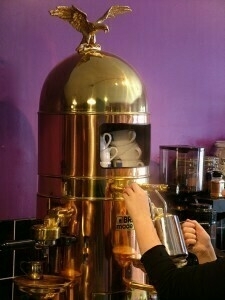
In the coffee shop environment I previously worked in, we used the machine below, a Basilia Belle Epoque, 2 Group. Although suffering from relatively small boiler size due to the vertical design there was enough pressure to run both groups and steam milk at the same time, for a fairly consistent period of time. Even though it was recommended here that it should not be used on a busy site, we rarely experienced problems.
Now at home I use a different setup, a Fracino Little Gem, 1 Group which I will admit is a pretty basic Prosumer machine and frequently has trouble with pressure, even still when you have the right workflow it is possible to brew and then steam without any detriment to the flavour of the cup. One major difference in this setup, that really doesn't help is the steam wand on the Fracino. I don't know if it's just me, but combined with my lack of practice, I don't seem to be able to get the same spin on the milk, regardless of which type of jug I use. And as any experienced Barista will tell you, its the spin of the milk, while stretching and steaming that creates the necessary texture to mix the milk and espresso and create impressive latte art. Latte art, which off-late has been disastrous on my part.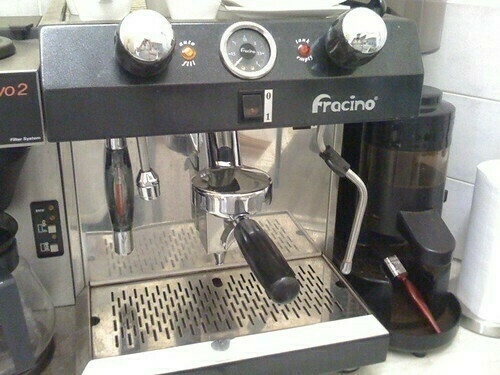 I've seen latte art created when using domestic krups machines, means I really doubt it's impossible, but it really goes to show, just how much your experience on a particular machine contributes to what you can do with it and with this year's UKBC having switched to Sanremo machines. Come Wednesday, I'll be at Hillsborough, unofficially reporting on the regional heat and will hopefully get to speak to a few of our local baristas and ask them how the changes this year have affected them to what lengths they have went to level the playing field. Maybe if you are good at what you do, the machine won't make a difference, in which case, hopefully I'll pick up a few tips.
I've seen latte art created when using domestic krups machines, means I really doubt it's impossible, but it really goes to show, just how much your experience on a particular machine contributes to what you can do with it and with this year's UKBC having switched to Sanremo machines. Come Wednesday, I'll be at Hillsborough, unofficially reporting on the regional heat and will hopefully get to speak to a few of our local baristas and ask them how the changes this year have affected them to what lengths they have went to level the playing field. Maybe if you are good at what you do, the machine won't make a difference, in which case, hopefully I'll pick up a few tips.
On some recent trip to Belfast's shiny new Apple Store, I took a walk down Anne Street (what is with the ugly half tile, have pot-holed tarmac street btw?) and found an absolute gem of a shop, The Cookie Box.
Now I know this blog is generally about coffee (or what passes as coffee) but to be honest I've never even tried any of the coffee there, because even walking past I was stopped in my tracks by the sights and smells of about a dozen different varieties of home made cookies. It's only a small shop, opposite Forbidden Planet, and most of the room is taken up by the kitchen, almost putting the counter on the street itself, but what it lacks in size it makes up for in taste. Crunchy but soft, gooey chocolate chips, oodles of butteryness making the cookies literally melt in your mouth. I'm sitting here and I can't even think of words to describe them, all that comes to mind, over and over again is the phrase:
Best. Cookies. Ever.
The owner works there and bakes the cookies himself. I know from my own experience how difficult working in that sort of environment can be so I wish him and his business all the possible success they can have. I for one will be back, again, next time I'm in Belfast and I think everyone else should too.
Go Cookie Man Go!